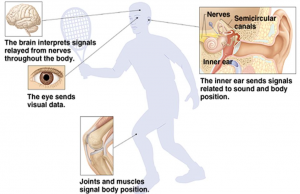At Active Seniors, we assess our members balance with eyes open and, where safe to do so, with eyes closed. For many people, there is a big difference between the two, with eyes closed proving to be much more challenging than anticipated. As a result, one of the most common questions we get asked is “why is it so much harder to balance with my eyes closed?”. Keep reading to learn the answer to this question and also why it is important to train this type of balance to reduce your risk of falling.
Maintaining balance requires the coordinated efforts of 3 different body systems; the eyes, the inner ear and the sensors in the body’s muscular system. The information from these systems all gets sent to the brain who uses it to determine the body’s position and the strategies it needs to use to maintain balance.

Each of the systems provides a unique perspective. The inner ear concentrates on head position and senses if the head is rotating or tilting in anydirection, as well as determining if we are moving forward, backward, up or down. The sensors in the muscular system, in particular those in the lower part of the body, relay information about areas that are being stretched and also pressure changes. The eyes determine our position relative to the horizon and use visual reference points to assess body position.
In an ideal world, all three systems contribute equally. In reality, the systems that we use more in day to day life assume a greater role. When we consider how active our eyes are in day to day life, it is easy to see how they become dominant in balance. While our muscular system works to move us around, most people’s days have periods where we sit and hence reduce the demands on the lower parts of the body. In contrast, most of the time when we are sitting, our eyes are still very active reading or scanning the environment – unless we are sitting down to have a nap!
Back to our balance test! When we stand heel to toe or on one leg with our eyes open we can use the information from our eyes as well as the other systems to keep us balanced. Closing our eyes removes the primary source of information, hence why it is much more challenging.
While it isn’t normal to walk around with our eyes closed, it is normal for our eyes to be distracted and for us to encounter environments where our vision is significantly reduced, such as at night time. This is the main reason that including exercises that train our balance with visual distraction are so beneficial to try and reduce the risk of falls.
For most people, balancing with their eyes closed is not a safe place to start. A couple of better options include changing the position of your head during a balance task, or trying to read something in front of you while maintaining a balance position. It is extremely important to make sure that you are in a safe balance environment when performing these exercises. We recommend to our members that where possible, home balance exercises are performed with their back in the corner of a room and with a chair in front. It is also important to choose a balance position that you can maintain with relative ease when you first add a challenge to your vision.
